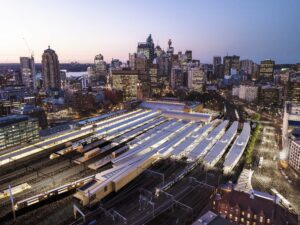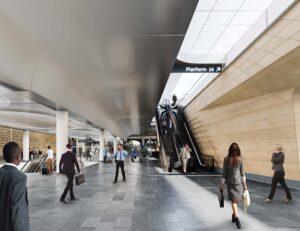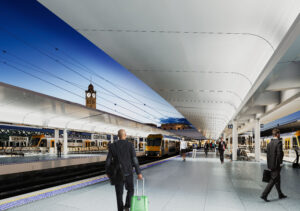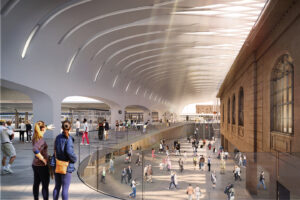Overview
Sydney Metro is Australia’s biggest public transport project. It will transform Sydney, delivering more trains and faster services across the network.
In 2018, Laing O’Rourke was awarded a $955 million contract to transform Sydney’s Central Station, delivering new Sydney Metro platforms beneath the station and an extensive pedestrian concourse, known as Central Walk. The project will revitalise and transform Australia’s busiest commuter hub.
Construction of the new metro platforms at Central Station is taking place in the area around and under the former platforms 13, 14 and 15 and between the suburban and country lines to the south.
Central Station Metro IS Rating boundary includes the upgrade and construction of new Sydney Trains Assets at the pre-existing Central Station. This includes:
- Two new underground concourses
- North South Concourse is a new underground concourse at Central Station oriented north-south above the new Metro station (and below reinstated surface platforms)
- Central Walk is a new underground pedestrian concourse at Central Station that will better connect passengers to trains, light rail and the new Sydney Metro underground platforms.
- The demolition and reinstatement (construction) of suburban rail platforms 12, 13 and 14, including shifting them southwest by 2.5m to incorporate the new Northern Concourse
- Refurbishment of the Northern and Grand Concourse at the north end of Central Station which links the existing and newly constructed parts of the station and serves as the main access points at Eddy Avenue. This includes a new vaulted roof and creation of a large void to reveal the existing heritage buildings at the access point from Eddy Avenue and existing Grand and Northern concourse.
- A new Eastern Entrance to enable commuter access from the eastern side of Chalmers Street from the light rail stop. This new entrance will be facilitated through the demolition and excavation below an existing building.
Rating Highlights
Energy and Carbon
100 year lifecycle carbon and energy modelling outcomes include:
- energy reduction of 36.53% compared to the base case footprint
- substitution of energy sources to renewable sources by 13.15% compared the base case footprint
The outcomes were due to the following efficiencies for the operational Sydney Trains assets:
- Lighting – LEDs,
- HVAC – variable speed drive,
- Elevator – regenerative braking, and
- Solar Power – generates 366.33MWh/year
Construction phase energy efficiencies include:
- B5 Biodiesel use, and
- 25% carbon offset of electricity
These include the substitutions to renewable energy sources:
- B5 biodiesel in construction, and
- Solar Power in operations.
Water
100 year lifecycle water consumption modelling outcomes include:
- consumption reduction of 20.48% compared to the base case footprint
- potable water substitution of 90% compared to the base case footprint
The outcomes are due to the following efficiencies for the operational Sydney Trains assets:
- WELS star rated toilets, urinals and taps above standard practice
Construction phase water efficiencies include:
- WELS star rated fixtures and fittings at site compound, and
- Misting / Fogging machine dust suppression techniques rather than hose pipes
Substitutions of potable water use were applied where non-potable water could be used, this includes:
- Use of rainwater for site compound ablutions and washdowns in construction, and
- Use of rainwater harvested from the Northern Canopy in toilets, urinals and for washdown throughout the station in operations.
Community Health and Wellbeing
Measures to positively contribute to community health and wellbeing for three priority issues have been identified and implemented. The priority issues of the community include:
- Workforce Development and Industry Participation
- Local jobs
- Local sustainable jobs (long term new employment)
- Australian and New Zealand Small to Medium Enterprise’s (ANZ SMEs) in the supply chain
- Support People Experiencing Homelessness or at Risk of Homelessness
- Integrated Transport for a Connected City
The following positive contribution measures are underway:
- Workforce Development and Industry Participation is tracking well with ANZ SME targets met early
- Support People Experiencing Homelessness or at Risk of Homelessness is tracking well with multiple long term and short term initiatives completed for charity partners Foster House (a mens shelter) and Women and Girls Emergency Centre (a women and children shelter).
- Upgrading the existing central station to enhance connectivity between transport modes and the surrounding areas. Community representatives provide insights to accessibility and connectivity and their positive responses have increased as design progressed.




